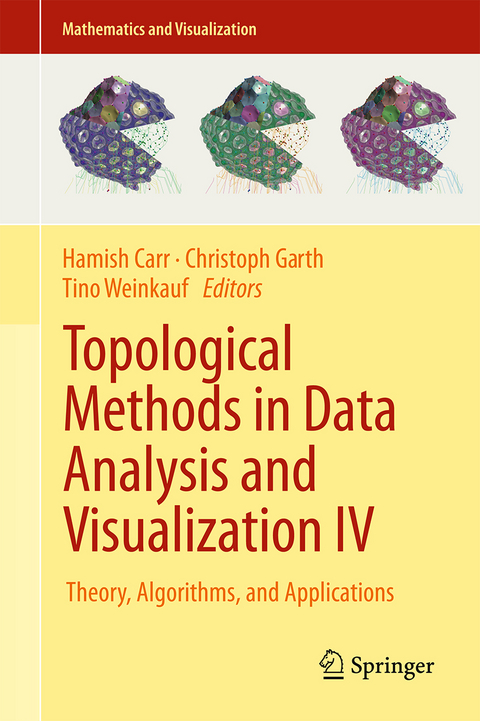
Topological Methods in Data Analysis and Visualization IV
Springer International Publishing (Verlag)
978-3-319-44682-0 (ISBN)
This book presents contributions on topics ranging from novel applications of topological analysis for particular problems, through studies of the effectiveness of modern topological methods, algorithmic improvements on existing methods, and parallel computation of topological structures, all the way to mathematical topologies not previously applied to data analysis.
Topological methods are broadly recognized as valuable tools for analyzing the ever-increasing flood of data generated by simulation or acquisition. This is particularly the case in scientific visualization, where the data sets have long since surpassed the ability of the human mind to absorb every single byte of data.
The biannual TopoInVis workshop has supported researchers in this area for a decade, and continues to serve as a vital forum for the presentation and discussion of novel results in applications in the area, creating a platform to disseminate knowledge about such implementations throughoutand beyond the community.
The present volume, resulting from the 2015 TopoInVis workshop held in Annweiler, Germany, will appeal to researchers in the fields of scientific visualization and mathematics, domain scientists with an interest in advanced visualization methods, and developers of visualization software systems.
Part 1: Topology-Based Analysis of Multi-Variate Data Sets: Theory of Singular Fibers and Reeb Spaces for Visualization: O. Saeki.- Topology-Based Analysis for Multimodal Atmospheric Data of Volcano Eruptions: A. Kuhn, W. Engelke, M. Flatken, F. Chen, H.-C. Hege, I. Hotz.- A Comparison of Joint Contour Nets and Pareto Sets: L. Huettenberger, C. Heine, C. Garth.- Part 2: Topological Techniques for High-Dimensional Data: Visualizing Topological Properties of the Search Landscape of Combinatorial Optimization Problems: S. Volke, D. Zeckzer, M. Middendorf, G. Scheuermann.- Computing and Visualizing Time-Varying Merge Trees for High-Dimensional Data: P. Oesterling, C. Heine, G. H. Weber, D. Morozov, G. Scheuermann.- Agreement analysis of quality measures for dimensionality reduction: B. Rieck, H. Leitte.- Part 3: Scalar Field Topology: Fast Similarity Search in Scalar Fields Using Merging Histograms: H. Saikia, H.-P. Seidel, T. Weinkauf.- Morse-Smale Analysis of Ion Diffusion in Ab Initio Battery Materials Simulations: A. Gyulassy, A. Knoll, P.-T. Bremer, B. Wang, K. Chun Lau, M. E. Papka, V. Pascucci, L. Curtiss.- Piecewise Polynomial Reconstruction of Scalar Fields from Simplified Morse-Smale Complexes: L. Allemand-Giorgis, G.-P. Bonneau, S. Hahmann.- Part 4: Vector & Tensor Field Topology: Topological Extraction of Escape Maps in Divergence-Free Vector Fields: R. Peikert, G. Machado, F. Sadlo.- Compute and Visualize Discontinuity Among Neighboring Integral Curves of 2D Vector Fields: L. Zhang, R. Laramee, D. Thompson, A. Sescu, G. Chen.- Decomposition of Vector Fields Beyond Problems of First Order and Their Applications: W. Reich, M. Hlawitschka, G. Scheuermann.- Maximum Number of Degenerate Curves in 3D Linear Tensor Fields: Y. Zhang, Y.-J. Tzeng, E. Zhang.- Part 5: Coherent Structures: Hierarchical Watershed Ridges for Visualizing Lagrangian Coherent Structures: M. Chen, J. C. Hart, S. C. Shadden.- Finite Time Steady 2D Vector Field Topology: A. Friederici, C. Rössl, H. Theisel.- Comparing Finite-Time Lyapunov Exponents in Approximated Vector Fields: S. Koch, S. Volke, G. Scheuermann, H. Hagen, M. Hlawitschka.- Transfer Operator-Based Extraction of Coherent Features on Surfaces: K. Padberg-Gehle, S. Reuther, S. Praetorius, A. Voigt.- Part 6: Software and Algorithms: ADAPT - Adaptive Thresholds for Feature Extraction: P.-T. Bremer.- Efficient Software for Programmable Visual Analysis Using Morse-Smale Complexes: N. Shivashankar, V. Natarajan.- Notes on the Distributed Computation of Merge Trees on CW-Complexes: A. Landge, P.-T. Bremer, A. Gyulassy, V. Pascucci.- Computing Invariants of Knotted Graphs Given by Sequences of Points in 3-Dimensional Space: V. Kurlin.
| Erscheinungsdatum | 26.04.2017 |
|---|---|
| Reihe/Serie | Mathematics and Visualization |
| Zusatzinfo | XI, 363 p. 153 illus., 129 illus. in color. |
| Verlagsort | Cham |
| Sprache | englisch |
| Maße | 155 x 235 mm |
| Themenwelt | Informatik ► Software Entwicklung ► User Interfaces (HCI) |
| Mathematik / Informatik ► Mathematik ► Graphentheorie | |
| Mathematik / Informatik ► Mathematik ► Wahrscheinlichkeit / Kombinatorik | |
| Schlagworte | analytic geometry • Analytic topology • Coherent Structures • Combinatorics and graph theory • Computer Graphics • Computing Methodologies • Data Analysis • Geometry • graphics programming • Manifolds and Cell Complexes (incl. Diff.Topology) • Mathematics • mathematics and statistics • Programming Techniques • Topology • Visualization |
| ISBN-10 | 3-319-44682-7 / 3319446827 |
| ISBN-13 | 978-3-319-44682-0 / 9783319446820 |
| Zustand | Neuware |
| Haben Sie eine Frage zum Produkt? |
aus dem Bereich


